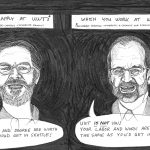Final Decision Made on UWT Minimum Wage
At 10:07 am on Jan. 12th, UWT Chancellor, Dr. Mark Pagano sent a campus-wide email regarding his final decision regarding UWT minimum wage. After ASUWT Minimum Wage Task Force administered a campus wide survey in December Chancellor Pagano determined UWT will follow ASUWT’s suggestion and student employees will now follow Tacoma’s $12 Later plan.
Chancellor Pagano’s email stated, “Our minimum hourly rate, therefore, will be $11 through 2016, and will move up to $11.15 in 2017, reaching $12 by Jan. 1st, 2018.”
The ASUWT Minimum Wage Task Force published their “Final Report,” which can be found on the ASUWT website, whose web address is located at the end of this article. In early January, Tacoma Ledger news reporter, Jude Hanno, wrote, “The results show that 56% of students want the $12 minimum wage. Another 28% want our campus to follow suit with UW Seattle and Bothell with the $15 minimum wage. The remaining 17% want our campus to create its own policy.”
The final report—in which Pagano used to make his final decision—was composed of 565 students (accounting for 13.1% of the student population). The survey resulted in a confidence level of 99% with a margin of error of 5%.
The report states, “response rates related to freshman were low,” and “there was a small overrepresentation of students working on campus as well.” There are currently approximately 300 student employees at UWT.
Two students relayed their concerns about the survey by emailing ASUWT Director of Finance, Bronwyn Clarke. These students accused the Minimum Wage Task force of administering a biased survey (email thread available on the final report). One accusation stated, “Your survey is highly biased, in that neither [option] considered the possibility of alternative viewpoints, nor allowed an option for expressing them.”
Clarke replied that the student had the option of selecting “Option C” while taking the survey to relay his/her opinion.
“Appendix B” in the final report contains a qualitative analysis. This analysis contains only the responses of those who answered Option C on question two. The sample size of the “Option C” group is 75 people, accounting for 13.27% of the survey. The survey results as a whole were not available in the final report.
The final report, organized by Clarke said, “Task Force members were appointed based on their indicated commitment to critically examining the different minimum wage policies, working toward an unbiased survey.”
During the introductory paragraph of question one of the minimum wage survey it states, “10 student employment positions were eliminated as the result of a cost-saving merger between two departments.”
When I asked Clarke about the possible implications of bias in this statement she said, “it was intended as a background question, I view that as a factual statement and a background statement about what happened.”
“I think it is a question of whether you want to balance not biasing people or withholding the relevant fact, “ said Clarke. “The task force decided that it was a relevant fact and that it was background information. So, we chose to use it so people were aware of all the background. Perhaps it can be construed as biased but, from the Task Force’s perspective, we were trying to make sure that students were aware of the relevant facts.”
However, as it states in the report, students have shared their concerns. Tori Olive, a newly graduated employee who has worked for the TLC for three years said, “I believe that if the union was made clear in the survey, or the students even knew about it that the answers [on the survey] would have been a lot different.”
The UW student union includes tutors, teaching assistants, graders, and lab assistants. Minimum wage for student union employees will be raised to $15, in concordance with both the Seattle and Bothell campus.
“From my perspective as a student government representative, I represented those views as did the task force by exclusively pointing them out during the presentation to the chancellor’s cabinet as well as in the final report.” said Clarke. “There is a fairly direct note in the student concerns portion that I think sums up their views fairly and objectively.”
“My issue has always been with the language they use,” said Olive, “It is almost as if they are implying that following the Tacoma model is going to affect every worker at UWT. And that’s just simply isn’t the case.”
Olive sent a letter to the Chancellor and started an online petition in attempts to gain student support to see both sides ($15/$12) of the minimum wage topic. The online petition is available at change.org.
The ASUWT recommended that the campus revisit the minimum wage issue every Fall before the scheduled increases in 2017 and 2018. “We wanted to make sure that students who had those views were not excluded from the conversation in the future, also that allows for future changes.” said Clarke.
“There are external factors that may change the content of the policy. Our recommendations were to allow for that continued conversation, to allow for the possibility that the student body as a whole that their opinion might change.”
As Olive and Clarke both said, “The talk [referring to minimum wage] is not over.” It has only just begun.






